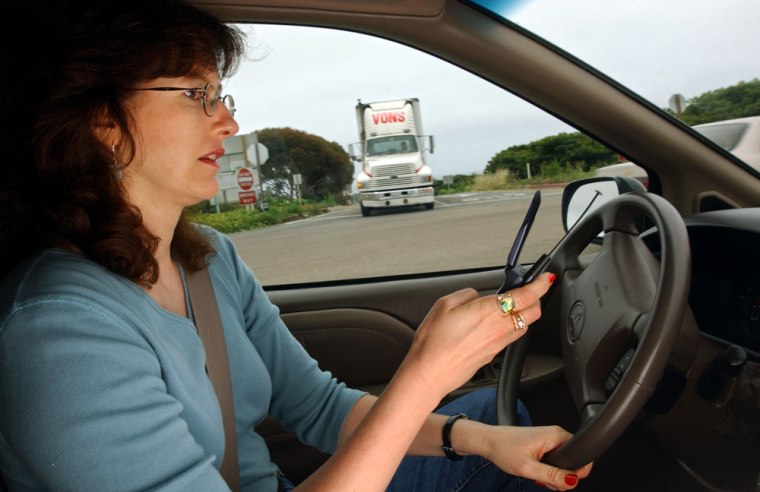A California researcher has entered the acrimonious debate over mobile phones by predicting that banning the use of hand-held phones by U.S. drivers could save thousands of lives each year.
In a study released Monday, Jed Kolko, a fellow at the nonpartisan Public Policy Institute of California, estimated that 300 fewer people will die each year in traffic accidents as a result of a pending hand-held cell-phone ban for California drivers. More than 4,000 people die in traffic accidents in the state every year.
Most of those lives will be saved when the roads are wet or the weather is bad, said Kolko, who came to his conclusions after poring over data from the handful of states that have banned the use of hand-held phones while driving.
Although he prepared no estimate for how many lives would be saved nationwide if hand-held phone use by drivers was banned in all states, Kolko said, “You’d be safe to say several thousand.”
Kolko’s study is sure to fuel two debates that have existed since cell phones became a common companion of drivers in the 1990s: whether phone use by drivers contributes to traffic accidents at all and whether hand-held versions are more distracting and dangerous than hands-free phones.
Previous studies “are all over the map,” Kolko said in his report. “Some find no effect from mobile phone use on collisions, and others find very large effects.” Those studies also relied on surveys of drivers and lab simulations, and did not predict the effects of hands-free laws, he said.
Surveying drivers is particularly problematic, Kolko said.
"Mobile phone use can't be measured accurately at the time of a traffic collision," he said. "A driver may hang up to avoid looking negligent, and police can't easily access mobile phone records."
Kolko’s study used data on mobile phone ownership and fatal wrecks across all 50 states. He then analyzed the effects of hands-free laws where they are in effect — Washington, D.C., New York, New Jersey, and Connecticut. ( In addition to California, a hands-free law will go into effect in Washington state July 1.)
No effect in good conditions
“Hands-free laws clearly reduce fatalities in bad weather and on wet roads,” Kolko told msnbc.com. The study concluded that the reduction in such adverse conditions was between 30 and 60 percent, depending on how long the law had been in effect.
To a lesser effect, the laws reduce fatalities during rush hour, he said. “They don’t seem to have an effect on fatalities in good driving conditions.”
For now, Kolko can’t explain the correlation. “It may be that drivers in states with hands-free laws are shifting their talking minutes to when they are not driving,” Kolko wrote in his study. “It could be that drivers find hands-free technology more cumbersome … (or that) the law in itself serves as an educational warning about the danger of talking on the phone while driving … (or) that hands-free technologies do reduce the physical distraction of using a phone, and earlier studies failed to detect this effect.”
A skeptical reaction
Russ Rader, a spokesman for the Insurance Institute for Highway Safety, which believes hands-free phone use while driving is just as dangerous as using a hand-held phone, had not seen the study, but was skeptical. “I’m not quite sure how researchers would have been able to extrapolate a lives-saved number in that study,” he said.
“All we can talk about is the research we have done and what the federal government has done that shows that the conversation itself is distracting and the risk is the same whether it’s a hand-held or hands-free phone.” Bottom line, Rader said: “We know that talking on a cell phone increases a driver’s risk of a serious crash fourfold.”
But California State Sen. Joe Simitian, author of the hands-free law that goes into effect in six weeks, was delighted to hear Kolko’s results. “It took me six years to get this bill passed” over heavy lobbying against it by the cell phone industry, he told msnbc.com. Only Verizon did not initially oppose the bill.
Simitian said he was able to keep pushing his bill through the statehouse and adding support from colleagues by pointing out hypocrisy on the issue from cell service providers. “It was a very ‘Alice in Wonderland’ conversation because all of them published brochures for their customers that said don’t talk on your cell phones while driving.”
By the time Gov. Arnold Schwarzenegger signed the bill into law in 2006, only Sprint was opposed, Simitian said.
Today Sprint has backed off and would not fight similar efforts in other states, said the company’s public affairs manager, John Taylor. “While we’re not opposed to them, we’re not sure it’s the best way to change driver behavior,” he said. The company believes phones are just one of many distractions faced by drivers and offers a “turn-key” program on driver awareness to educators and others.
The Wireless Association, the cellular phone industry's trade group, is “neutral on hands-free laws," said John Walls, vice president of public affairs. "We think it’s really up to an individual state. Whether they’re necessary or not, people can argue all day."
Since there are so many potential distractions to drivers, “to isolate one and think you’ve licked the problem is really doing everyone an injustice,” he said.
Nevertheless, Kolko expects more states to follow California, whose 23 million licensed drivers far outnumber those in any other state, “just as we’ve looked at what happened in New York.”
Bet on that, agreed Simitian, who said he was contacted recently on the topic by a legislator from Louisiana.
Simitian, a Democrat from Palo Alto, said Kolko’s estimate of 300 fatalities a year being prevented by the law gives him “a very satisfying feeling … knowing that every day that passes in California, there’s at least one life saved.”
